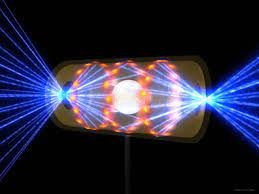Bill McKibben in The New Yorker:
 On Tuesday, the Department of Energy is expected to announce a breakthrough in fusion energy: according to early reports, scientists at the government’s Lawrence Livermore National Laboratory, in California, have succeeded for the first time in making their complex and expensive machinery produce more power than it uses, if only for an instant. It’s a breakthrough of great significance—in essence, the researchers are learning to build a second sun. And it was greeted with the requisite hosannas—the Washington Post described it as a “holy grail,” a “major milestone in the decades-long, multibillion-dollar quest to develop a technology that provides unlimited, cheap, clean power.”
On Tuesday, the Department of Energy is expected to announce a breakthrough in fusion energy: according to early reports, scientists at the government’s Lawrence Livermore National Laboratory, in California, have succeeded for the first time in making their complex and expensive machinery produce more power than it uses, if only for an instant. It’s a breakthrough of great significance—in essence, the researchers are learning to build a second sun. And it was greeted with the requisite hosannas—the Washington Post described it as a “holy grail,” a “major milestone in the decades-long, multibillion-dollar quest to develop a technology that provides unlimited, cheap, clean power.”
That it comes with equally requisite caveats does not diminish the glory of the achievement, but they’re important, too. As a fusion expert at the University of Cambridge, in England, told CNN on Monday, “This result is miles away from actual energy gain required for the production of electricity. Therefore, we can say (it) is a success of the science but a long way from providing useful energy.” Among other things, producing this reaction required one of the largest lasers in the world, and the reaction creates neutrons that can destroy the very equipment required to produce it. As the Post put it, “Building devices that are large enough to create fusion power at scale” would “require materials that are extraordinarily difficult to produce.” It is therefore still “at least a decade—maybe decades—away from commercial use.”
More here.
